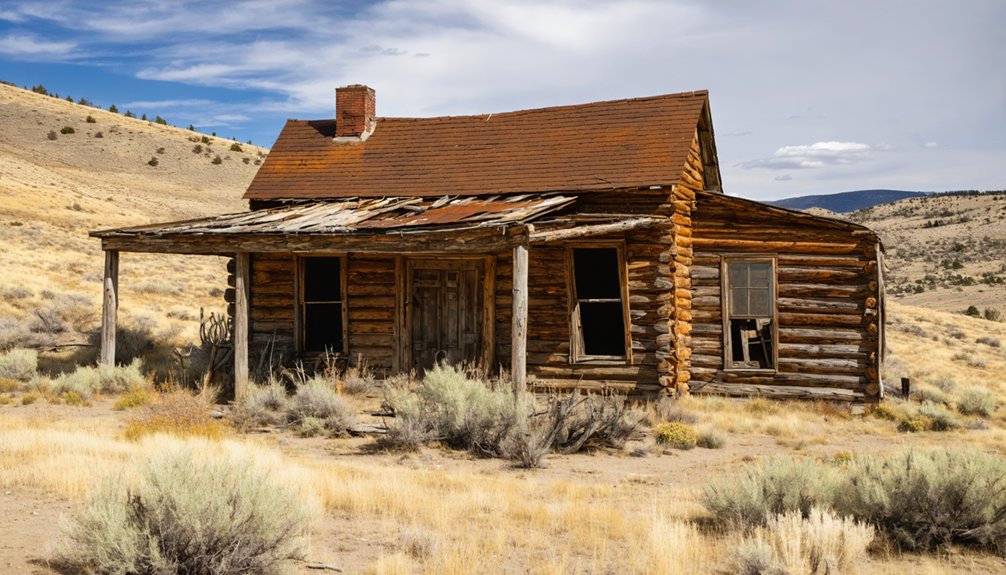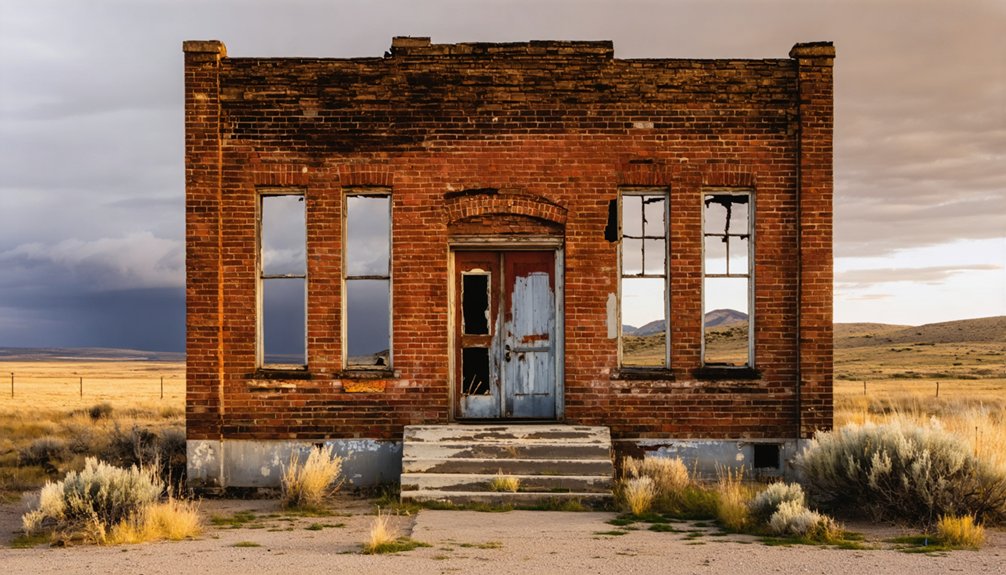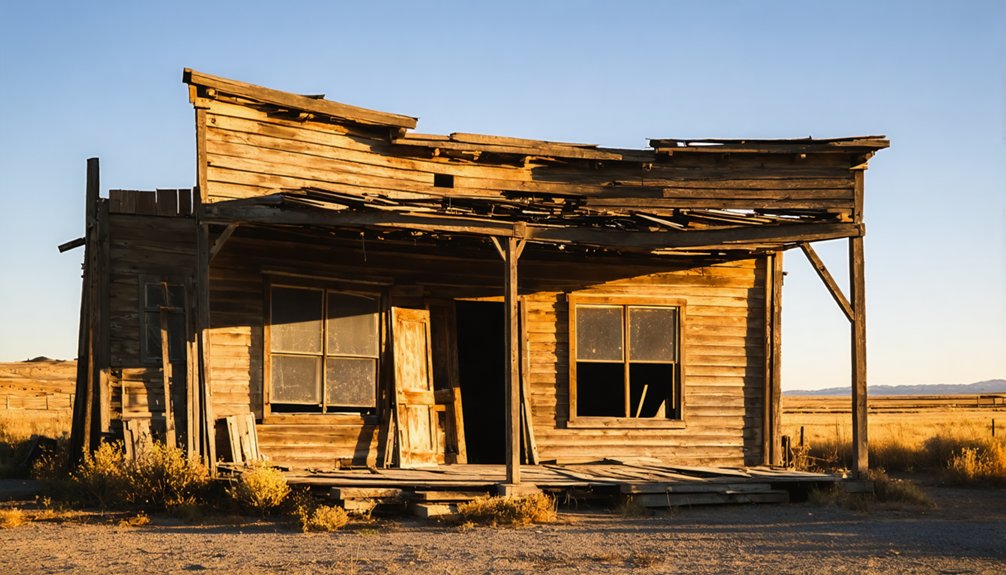You’ll find Poison Creek Stage Stop‘s historic stone buildings near Homedale, Idaho, where it served as an essential waystation along the Oregon Trail in the 1800s. This once-bustling stop provided travelers with lodging, meals, and fresh horses while functioning as a critical mail distribution center between Boise and mining settlements. Though weathered by time, its thick stone walls and root cellars still stand as evidence of frontier ingenuity, with each worn stone holding countless tales of pioneer life.
Key Takeaways
- Poison Creek Stage Stop operated as a crucial waystation on the Oregon Trail near Homedale, Idaho, serving travelers with lodging and provisions.
- Built in 1913, the stone structures include a main house, stable, and outbuildings that reflect frontier architectural style and survival needs.
- The site functioned as both a stagecoach stop and post office, connecting Boise to mining settlements in southwestern Idaho.
- Historic buildings face preservation challenges from weather damage, vandalism, and artifact theft, threatening the site’s historical integrity.
- The abandoned station now stands as a ghost town, offering visitors insight into 19th-century pioneer life and stagecoach travel.
A Pioneer Rest Stop Along the Oregon Trail
While thousands of pioneers journeyed westward along the Oregon Trail in the late 19th century, Poison Creek Stage Stop emerged as an essential waystation near present-day Homedale, Idaho.
You’d find this critical hub offering fresh horses, provisions, and a safe haven during your westward trek. The stop’s pioneer logistics included a main house, barn, root cellars, and wells that served both travelers and stagecoach lines. Supplies were carefully stored on large boulders to protect them from wild animals.
As native interactions shifted from peaceful coexistence to increased tension, the stop became vital for your survival. Disease outbreaks along the trail claimed many lives, with cholera killing 5,000 emigrants in 1852 alone.
Known to Native Americans as part of “The Great Medicine Road of the Whites,” this station helped you manage travel timing, avoid hazardous conditions, and gather in armed groups when necessary.
Native wisdom called it The Great Medicine Road of the Whites – a lifeline for pioneers seeking safety in numbers and refuge.
Here, you could rest, regroup, and prepare for the challenging terrain ahead.
The Stone Buildings and Structures
The stark beauty of Poison Creek Stage Stop‘s stone buildings stood as a tribute to frontier ingenuity and resourcefulness.
When you explore these ruins today, you’ll find foundations that reveal the stage stop’s strategic layout, including the main house, stable, and several outbuildings. The historic structure, built in 1913, represents a crucial period in Idaho’s development.
The architectural resilience of local stone proved essential for surviving Idaho’s harsh climate, offering superior durability compared to wooden structures.
- The thick stone walls protected pioneers from bitter winters and scorching summers
- Two root cellars carved into stone kept food preserved year-round
- The stone schoolhouse served as both an educational center and symbol of community permanence
You can still trace the careful stonework in the foundations, where rough-cut masonry and fieldstone construction techniques showcase the craftsmanship of early Idaho settlers.
Life at a 19th Century Stage Station
At a 19th century stage station like Poison Creek, you’d witness station staff starting their day before dawn to prepare meals, tend horses, and coordinate incoming coaches that arrived on strict schedules.
You’d find travelers gathering in common areas to rest, share news from distant towns, and enjoy basic but filling meals while station workers managed the constant flow of mail, freight, and passenger logistics. The station rules strictly prohibited rough language use when ladies and children were present. The home stations were positioned every twelve miles to provide fresh teams and accommodations for travelers.
As night fell, you’d see weary stage drivers and passengers settling into simple lodgings while station staff prepared for the next day’s operations, maintaining the essential communication and transportation link between isolated frontier communities.
Daily Routines and Tasks
Running a 19th century stage station demanded precision timing and tireless dedication from sunrise to sunset.
You’d start each day with essential daily horse care – feeding, watering, and grooming the animals while checking them for injuries or fatigue. Equipment maintenance couldn’t wait; you’d inspect coaches, repair harnesses, and oil moving parts to prevent breakdowns on the trail. Similar to the station operated by William Oakley in what would later become Oakley, Idaho, these stops were crucial waypoints for travelers.
- By dawn, you’re coordinating with nearby stations about schedules, weather alerts, and road conditions.
- Throughout the day, you’re managing horse changes, passenger transfers, and keeping detailed records.
- As darkness falls, you’re securing the grounds, tending the fires, and preparing for tomorrow’s challenges.
The station’s success depended on your ability to keep operations flowing smoothly while protecting valuable assets from threats both natural and human.
Lodging and Food Service
Life at Poison Creek Stage Station revolved around providing essential lodging and meals for weary travelers crossing Idaho’s rugged frontier. You’d find yourself staying in the main house, built from local stone and timber, where station families prepared hot, hearty meals on wood-fired stoves.
These lodging experiences included overnight rooms with basic frontier amenities. The station’s meal traditions centered on simple, filling fare stored in root cellars and supplemented by the chicken coop’s fresh eggs.
You’d share your evening meal with other travelers while station staff tended to your horses in the barn. The resident family juggled multiple duties – from cooking and cleaning to teaching at the schoolhouse and managing postal services – ensuring you’d have a comfortable rest stop on your journey through the territory.
Mail and Passenger Operations
Beyond its role as a rest stop, Poison Creek Stage Station buzzed with mail and passenger operations that kept Idaho’s frontier communities connected.
You’d find stagecoaches arriving at dawn, carrying both mail and passengers on their carefully scheduled routes. Mail delivery remained the priority, operating even through harsh winters when horse-mounted carriers would forge ahead on snowshoes. Like the historic Wickahoney Post Office, these stops were vital landmarks for travelers navigating the rugged terrain.
- You could book passage for $10-$20, joining miners and settlers heading to remote destinations.
- You’d witness the daily rhythm of mail sorting and dispatch, a lifeline connecting isolated towns.
- You’d find yourself part of a crucial communication network that helped build the American West.
The station’s combined services of passenger transport and mail handling made it an essential hub in Idaho’s transportation system, supporting the region’s growth and independence.
Architectural Legacy in Idaho’s Wilderness
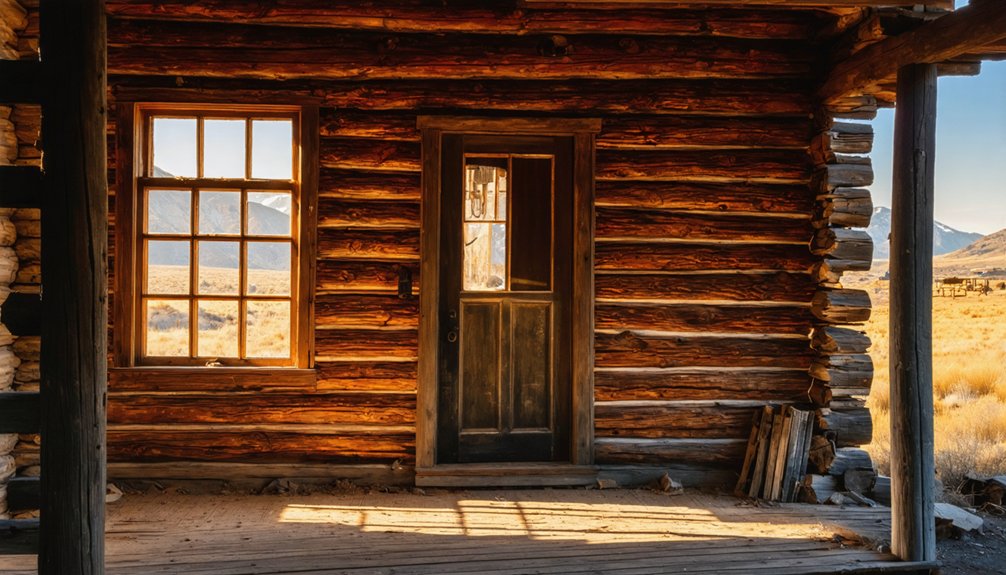
Nestled in Idaho’s rugged wilderness, the Poison Creek Stage Station stands as a tribute to early frontier architecture, earning its place on the US National Register of Historic Places. Dating back to the late 1880s, with the current structure built in 1913, this rural architecture masterpiece showcases the practical ingenuity of frontier builders.
You’ll find a remarkable collection of surviving structures that highlight the station’s historical significance. The main house serves as the centerpiece, while the barn, root cellars, and schoolhouse tell the story of a self-sufficient community.
Each building, from the chicken coop to the outhouse, represents the resourcefulness of early settlers who crafted functional spaces using local materials.
Today, these enduring structures offer you a glimpse into Idaho’s pioneering spirit and the architectural heritage that shaped the American West.
Mail Routes and Communication Hub
You’ll find Poison Creek Stage Stop‘s most essential role centered on its mail service operations, which connected Boise to numerous mining settlements throughout southwestern Idaho’s rugged frontier.
The station’s strategic location made it an indispensable hub where stagecoach drivers transferred mail, newspapers, and parcels between routes heading to different communities in the 1800s.
Despite challenging weather conditions and poor roads, the stop’s infrastructure – including its main house, barn, and storage facilities – supported consistent postal operations that kept frontier communities connected and informed.
Postal Service Evolution
As frontier settlements expanded across Owyhee County in the early 1900s, Poison Creek Stage Station emerged as an essential communication hub that transformed local postal services.
You’ll find that mail service operations evolved from sporadic stops to formalized logistics as the region developed, connecting remote communities to commercial centers like Boise and Silver City.
- The station’s transformation from a simple stage stop to a full-fledged post office empowered settlers with reliable communication access.
- Your ancestors relied on this crucial link for staying connected across Idaho’s rugged terrain before modern telecommunications.
- The station’s multiple buildings, including root cellars, enabled year-round mail service despite harsh seasonal challenges.
As automobile transport and telephones emerged, Poison Creek’s role in communication evolution shifted, though its historical significance endures as a symbol of frontier postal development.
Stage Stop Mail Operations
Operating from its strategic position between Boise and the mining districts, Poison Creek Stage Stop functioned as an essential mail distribution center throughout the 1860s and beyond.
You’d find stagecoach drivers and mail carriers stopping here weekly, utilizing the station’s mail sorting facilities while their horses rested in the nearby barn. The stage logistics involved coordinating with other stops like The Rocks and Canyon Creek to maintain reliable delivery schedules across southwestern Idaho’s challenging terrain.
The stop’s infrastructure supported crucial communication services, housing a temporary post office that connected mining camps, agricultural settlements, and government outposts.
Whether you needed to send newspapers to Silver City or receive correspondence from Rocky Bar, Poison Creek’s position in the regional mail network made it indispensable for frontier communication needs.
From Bug Town to Rockville: A History

In the rugged terrain of southwestern Idaho, “The Rocks” emerged as an important waypoint for freight wagons traveling between the Boise Valley and Silver City.
You’ll find this spot was named for a prominent boulder where wagon drivers would store their supplies safely above ground, away from wildlife.
Just as nearby Caldwell was once known as Bug Town, this rest stop would evolve into what we now know as Rockville.
- Feel the pioneer spirit as you imagine freight wagons pulling up to the massive boulder
- Experience the sense of relief travelers felt finding shelter at this important stopover
- Witness the transformation from simple rock to thriving community hub
The site gradually developed into a formal stage stop, complete with a post office and census precinct, as families settled and built permanent structures to serve the growing number of travelers.
Preservation Challenges and Heritage Value
While time has taken its toll on the Poison Creek Stage Station‘s historic structures, the site’s preservation challenges extend far beyond natural weathering.
The sandstone buildings, including the main house, barn, and schoolhouse, face continuous threats from Idaho’s harsh climate and encroaching vegetation. Without proper preservation techniques, these irreplaceable structures risk being lost forever. Like the nearby Canyon Creek Stage Station, a devastating fire in the 1970s highlights how quickly historical structures can be destroyed.
You’ll find that human activity poses additional risks. Vandalism, artifact theft, and unregulated access threaten the site’s historical integrity.
Yet, this former Oregon Trail stop holds tremendous heritage value as a window into 19th-century pioneer life. The surviving architecture and scattered documentation tell stories of stagecoach travel, rural education, and frontier commerce.
With increased community involvement and proper stewardship, this cultural treasure could become a crucial educational resource for future generations.
Stories From the Sagebrush Desert
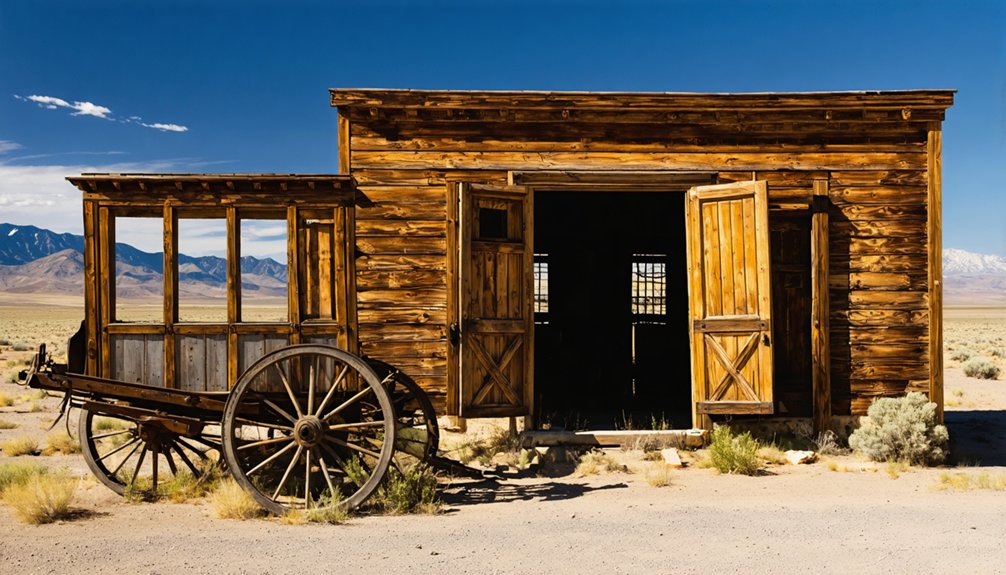
From its humble beginnings as “The Rocks,” Poison Creek Stage Stop emerged as more than just a waypoint for weary travelers crossing the Idaho sagebrush desert.
Pioneer anecdotes tell of the Proud and Naramore families transforming this rugged outpost into a thriving hub of desert life, where sagebrush legends were born among the daily rhythms of frontier existence.
You’ll find these enduring stories of determination:
- Freighters cleverly storing supplies atop boulders to outsmart wildlife, returning weeks later to find their cache intact
- Children growing up in the shadow of the schoolhouse, where education meant survival
- Multiple generations of families building lives around the stage stop, transforming a simple waystation into a vibrant community center
These tales paint a picture of resourcefulness and resilience in Idaho’s untamed landscape.
Frequently Asked Questions
How Many Stagecoach Robberies Occurred at Poison Creek Stage Stop?
You won’t find confirmed stagecoach robberies in the historical record for this location, though Idaho’s stagecoach history shows robbery frequency was high elsewhere throughout the territory during the 1860s-1880s.
What Happened to the Last Family Who Lived There?
You’d think you’d find tales of ghost sightings, but the last family, the Prouds, simply moved on after 18 months of development work, leaving their legacy through photographs and journals they’d maintained.
Are There Any Documented Paranormal Activities at the Site?
You’ll find documented ghost sightings around the old cemetery, with shadowy figures appearing at dawn and dusk. Paranormal investigations have captured footsteps, rustling skirts, and Mrs. Stricker’s friendly spirit near the buildings.
What Was the Average Length of Stay for Travelers?
Time flies when you’re on the trail! Based on typical travel duration patterns, you’d stay between a few hours to overnight, just long enough to rest horses and grab a meal.
Did Any Notable Historical Figures Pass Through Poison Creek?
While you won’t find records of famous travelers at this historic waypoint, its historical significance lies in serving countless unnamed pioneers moving through Idaho’s frontier during the late 1880s.
References
- https://kc7jsd.wordpress.com/2013/09/12/stage-stop/
- https://history.idaho.gov/wp-content/uploads/2018/09/Poison_Creek_Stage_Station_78001089.pdf
- https://www.onlyinyourstate.com/state-pride/idaho/historic-site-worth-a-stop-id
- https://www.idahogeology.org/pub/Bulletins/B-22.pdf
- https://www.blm.gov/press-release/history-comes-alive-canyon-creek-stage-station
- https://www.legendsofamerica.com/great-medicine-road/
- https://www.blm.gov/sites/default/files/documents/files/Library_Idaho_CulturalResourceSeries01.pdf
- https://commons.wikimedia.org/wiki/File:Poison_Creek_Stage_Station_2015_S-E_elevations_-_Homedale_Idaho.jpg
- https://yellowpinetimes.wordpress.com/2016/06/19/idaho-history-week-of-june-19/
- https://history.idaho.gov/wp-content/uploads/0465_South-Boise-Stage-Lines.pdf
